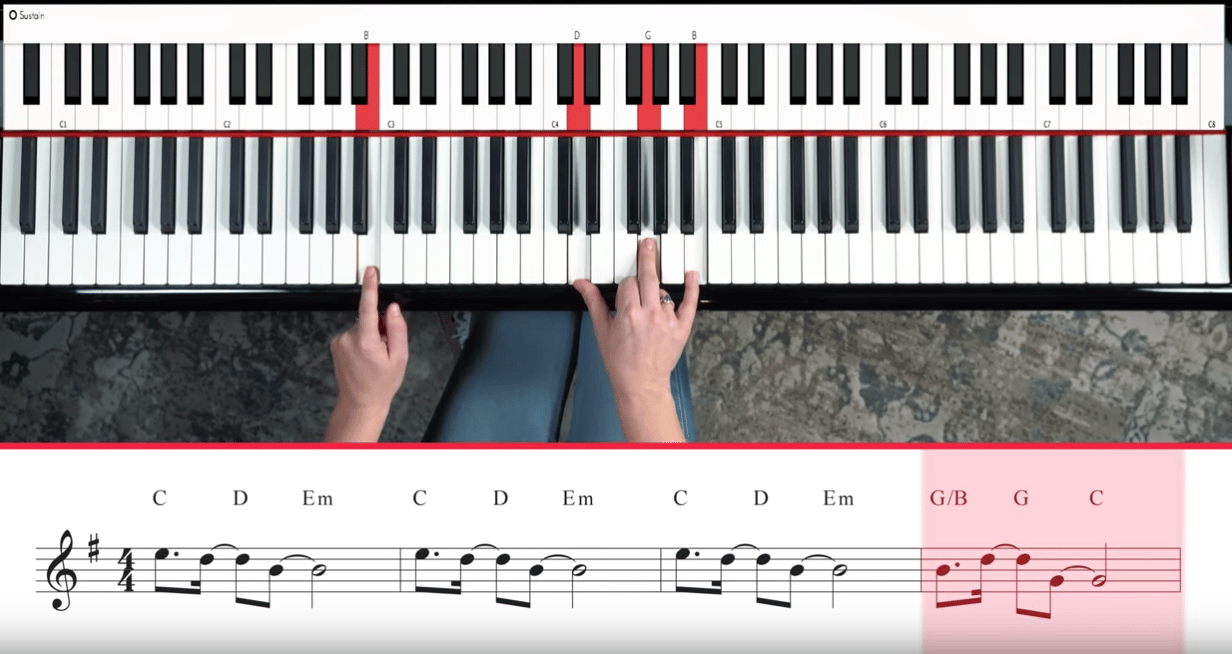<< Download the FREE lead sheet here >>
I LOVE it when popular songs not only sound beautiful but are easy to play.
Needless to say, I love this lesson.
“Ocean Eyes” is my favorite Billie Eilish song, even if it’s not the one that won her the GRAMMY.
There are really only 3 chords for the main part, and the chords are easy to play once you learn their inversions. And speaking of inversions, I’m going to be using a couple of them today, so if you need a refresher (or a lesson) check out our lesson on what inversions are and how to play them.
Let’s start by looking at the first line of the song:

Looking at the key signature we can see that this is in the key of G major (or E natural minor if you prefer). There’s only F# to worry about, and every chord you see should be familiar.
The lead sheet shows the melody with the chords written above, so it’s up to you to fill in the rest.
What I recommend is playing the C major chord in 2nd inversion. So the notes will be G – C – E. Then play the D chord in 1st inversion, so the notes will be F# – A – D. And then for the Em chord just play that in root position – E – G – B.
By playing the chords this way you’ll be keeping the melody note on top of every chord, which is what we want.
In the Left Hand, play the root and 5th of each chord. You can also just play single notes if you like.
As you do that, you’ll notice that your Left Hand is playing UP the keyboard, while your Right Hand is playing DOWN. This contrary motion sounds really nice and it’s also a great way to practice your hand independence!
And you know what? After learning that FIRST MEASURE — you’ve learned 95% of the song.
There’s just one more thing to cover…
Right there at the end of the line. And at the end of every similar sequence, you’ll see a G/B – G – C progression.
That G/B can be confusing. It’s called a “slash chord” and it just means you play a G chord in the Right Hand with a B note in the bass. I like to use the 2nd inversion for the G chord.
Take a look:

See the G chord in the right? The notes are D – G – B. That’s the 2nd inversion. And just a simple B note in the left.
Easy! If you don’t like that B in the bass, you can also play a G — it sounds fine.
The next chord is a straight G chord, which I like to play in root position, so the notes are G – B – D.
Then you just resolve to the C, also in root position. Again, these chord shapes keep the melody note on TOP, which is what you want, because your ear naturally hears the top note as the melody.
The melody is really the only thing that changes throughout the song from verse to chorus. The chords are IDENTICAL — although I do play them in different inversions for the chorus. Watch the lesson to see those.
I also like to add octaves in the bass for the chorus to help build it up, but you can do whatever you like.
I told you it was a beautiful, simple song!
So listen to the original, and then try to come up with your own interpretation of it.
And as always, have fun!
Lisa Witt has been teaching piano for more than 20 years and in that time has helped hundreds of students learn to play the songs they love. Lisa received classical piano training through the Royal Conservatory of Music, but she has since embraced popular music and playing by ear in order to accompany herself and others. Learn more about Lisa.
/marketing/pianote/promos/april/banner-bg-m.webp)
We use cookies for traffic data and advertising. Cookie Policy »
/marketing/pianote/promos/april/banner-title.webp)